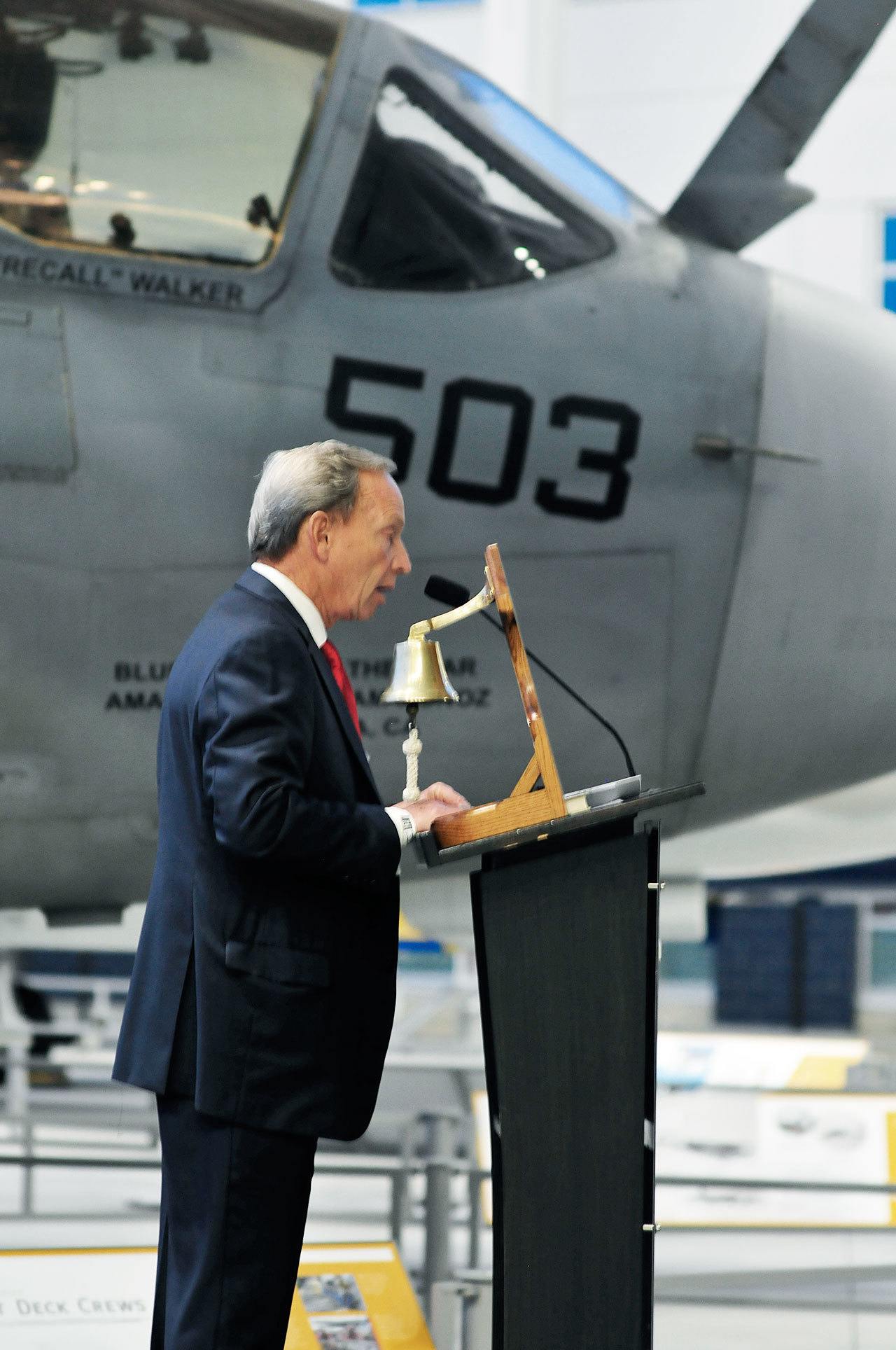The legacies of the venerable A-6 Intruder and those who made it fly were recognized by nearly 400 people during a ceremony Friday at the Museum of Flight in Seattle.
A laser-etched granite obelisk highlighting the history and capabilities of the Grumman aircraft was presented by retired United States Navy Capt. Larry Yarham to Doug King, the Museum of Flight’s president and chief executive officer.
Yarham is a former Intruder pilot and member of the Intruder Association.
King told the crowd it was an honor that the monument and aircraft are now included among the flight museum’s displays. He also said it was fitting that the dedication ceremony was held on Veterans Day.
The memorial at the Seattle museum is the fourth in a series of A-6 tributes held at aviation museums around the country.
It all started with a vision for preserving the story of the A-6 Intruder as well as those of the men and women who built it, flew it and maintained it, said Dave Williams, a retired Navy captain, current Oak Harbor Marina harbormaster and the northwest regional director for the Intruder Association.
Fundraising events were held to pay for the first tribute, which was placed at the National Naval Aviation Museum in Pensacola, Fla., according to Williams.
“The response was overwhelming,” he said. “We have plans for a total of six tribute memorials.”
Williams also told the flight museum audience about the challenges of finding a home for the latest memorial.
“We wanted to make sure this tribute stayed connected with Whidbey Island and the air station,” he explained. “We could not find a suitable place in Oak Harbor.”
If the memorial had been installed on Naval Air Station Whidbey Island, which is federal property, only those with base access would be able to see it.
Intruder Association members also discussed placing the monument with the static A-6 and EA-6B Prowler display on at the intersection of State Highway 20 and Ault Field Road, but said that location wasn’t suitable because there’s no designated parking.
“We wanted this memorial to be accessible to everyone,” said Williams.
After obtaining approval from the Museum of Flight, the memorial found its home, but it sat in storage for several months until after the museum’s new covered aviation pavilion was completed, he said.
The memorial is now displayed next to an A-6 Intruder dedicated to the aircraft known as Viceroy 502 and its aircrew, Lt. Roderick “Rog” Lester and Lt. Harry Mossman.
Lester and Mossman took off from the aircraft carrier USS Kitty Hawk CV-63 on Aug. 20, 1972 and were never seen or heard from again until 25 years later. A Department of Defense joint task force recovery team located the Intruder crash site and the Navy men’s remains.
Delivering the keynote speech was former Whidbey Island resident Stephen Coonts, a retired A-6 flier, Vietnam veteran and best-selling author of many novels about the aircraft, including “Flight of the Intruder,” which was later made into a motion picture 1991.
“This memorial is not about the aircraft,” said Coonts, but rather it’s about the A-6 community and the people involved with it over its 34-year history.
“Finally, and most importantly, this memorial is for all the POWs, those shipmates who fell and were captured by the enemy, and those families who waited so patiently, praying as their warriors suffered,” Coonts said.
Intruder squadrons were based at NAS Whidbey from 1966-97.
Among those from Oak Harbor who attended the memorial’s unveiling were: members of Oak Harbor High School NJROTC; Rear Adm. Gary Mayes, commander, Navy Region Northwest; Rear Adm. Marcus Hitchcock, Commander, Carrier Strike Group Three; Capt. Geoffrey Moore, commanding officer for NAS Whidbey; Capt. Scott Farr, commanding officer for Electronic Attack Wing Pacific; Oak Harbor Mayor Bob Severns; and state Sen. Barbara Bailey and her husband Butch Bailey, a retired Navy captain and former Intruder pilot.



